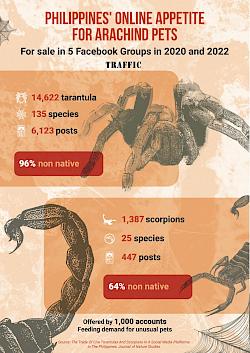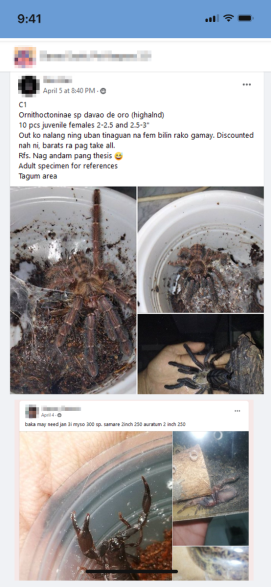Creepy, crawly and critical: Tarantula and scorpion trade in the Philippines unveiled
Usually the stars of horror stories, tarantulas and scorpions might be widely feared, but a recent study from the Philippines shows that the often-misunderstood creatures are equally admired and sought-after in trade.
The online research that looked at the trade in selected Facebook groups found an unexpectedly high level of trade in threatened and endemic species of tarantulas and scorpions in the country. 
The international trade of live arachnids as pets is widespread, with undescribed or newly described species being particularly sought-after by enthusiasts due to their novelty and perceived rarity. However, this has not been studied in the Philippines before.
Arachnids are invertebrates that typically have eight legs, and include spiders, scorpions, mites and ticks.
To establish baseline data on trade dynamics of arachnids, TRAFFIC researchers surveyed five Facebook groups in the Philippines specializing in the trade of live arachnids in 2020 and 2022.
At least 14,662 tarantulas representing at least 135 species from 6,123 posts and 1,387 scorpions of 25 species from 477 posts were recorded in the two surveys.
Most were of non-native species: 96% of tarantulas and 64% of scorpions recorded (by volume) were non-native.
The most offered tarantula was the Curly Hair Tarantula Tliltocatl albopilosus with 1,176 individuals recorded. This is a globally popular, CITES* Appendix II-listed species from Costa Rica and Nicaragua; while easy to keep and breed in captivity, it is still intensively wild-sourced.
Legality in sourcing and trade was flagged as a concern in the study The Trade Of Live Tarantulas And Scorpions In A Social Media Platform In The Philippines, published in the Journal of Nature Studies.
Of 42 arachnid species where international trade is regulated under CITES, 28 tarantula and one scorpion species were recorded in this study. CITES permits are required to legally import these.
Some species could have been captive-bred, but to legally trade in threatened or CITES-listed species in the Philippines, a Wildlife Farm Permit is required.
Other non-native arachnids that are newly discovered, rare, or difficult to breed in captivity would be illegal wild-sourced and regularly smuggled regularly by post into the country, as evidenced by a spate of seizures by the Bureau of Customs including of a gift-wrapped package from Poland containing 757 tarantulas in 2019.
Although present in smaller numbers, native arachnids in trade are of conservation concern. These were recorded to be poached and illegally shipped domestically and internationally to supply the pet trade and to a lesser extent, the scientific community.

For example, the endemic Palawan Blue Dwarf Tarantula Phlogiellus johnreylazoi was already offered in local and international markets before being described as a new species in 2016.
TRAFFIC’s Emerson Sy and co-author of the study:
Many native tarantulas are still undescribed, likely to be endemic and highly localized in distribution, and have not yet been evaluated by the IUCN Red List of Threatened Species. This makes them high risk of being overexploited.”
Over 1,000 unique Facebook accounts were recorded offering these arachnids for sale, with the most active traders largely located in central Luzon.
A Philippine wildlife seizure analysis from 2010-2019 identified arachnids as the most seized invertebrates with 2,994 tarantulas from 38 taxa and 992 scorpions from four taxa, underscoring the need for closer scrutiny.
Serene Chng, TRAFFIC Southeast Asia Programme Manager and co-author said:
We congratulate Philippine wildlife authorities for successful interceptions of trafficking attempts thus far and urge continued vigilance to disrupt arachnid smuggling, both on online platforms and at international ports. The private sector – specifically online platforms and courier services – also have crucial roles to play. We urge them to collaborate with law enforcement agencies to ensure that they are not implicated in the online trade and transport of illegal wildlife.”
Notes:
CITES: The Convention on International Trade in Endangered Species of Wild Fauna and Flora



